Table of Contents
The Pew Research Center in its study “The Future of World Religions” has estimated that by the year 2050, Islam will become the most followed religion in the world. The Indian census is scheduled to take place in 2025. This article examines the Muslim population in India, their regional distribution, and projected demographic trends for the community.
Muslim Population in World
Muslims are followers of the religion Islam, who believe in and live by the teachings of the prophet Muhammad. There are more than two billion Muslims worldwide, making Islam the second-largest religion in the world, exceeded only by Christianity. In fact, many researchers project that Muslims will outnumber Christians by the year 2050.
Although Muslims can be found all over the world, the majority live in northern and central Africa, the Middle East, and Southeast Asia. Many countries in these regions are more than 90% Muslim, including Egypt, Afghanistan, Syria, Pakistan, Turkey, and Iran. Any country in which Muslims make up 50% or more of the population is considered a Muslim-majority country.
The country with the largest number of Muslims overall is Indonesia, which is home to over 242 million Muslims. This is about 87% of the Indonesian population and 11.7% of the world’s total population of Muslims.
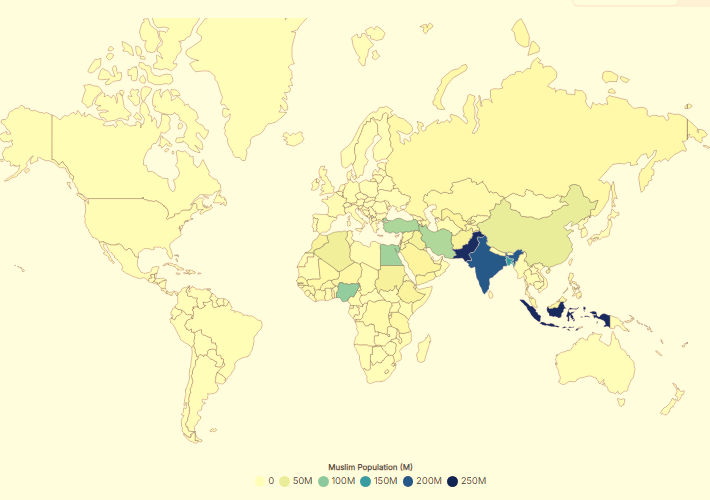
Image Credit: World Population Review
Top 10 Countries with the Largest Number of Muslims (2021)
| Country | Muslim Population(M) |
| Indonesia | 242,700,000 |
| Pakistan | 240,760,000 |
| India | 200,000,000 |
| Bangladesh | 150,800,000 |
| Nigeria | 97,000,000 |
| Egypt | 90,000,000 |
| Turkey | 84,400,000 |
| Iran | 82,500,000 |
| China | 50,000,000 |
| Algeria | 43,737,096 |
Top 10 Countries with the Highest Percentage of Muslims (2021)
| Country | % Muslim |
| Maldives | 100% |
| Mauritania | 99.89% |
| Somalia | 99.8% |
| Afghanistan | 99.7% |
| Iran | 99.4% |
| Western Sahara | 99.4% |
| Yemen | 99.07% |
| Algeria | 99% |
| Morocco | 99% |
| Mayotte | 98.8% |
History of Muslims in India
Islam was first introduced to North India with the Arab invasion of Sind in 712 CE, followed by further invasions during the eleventh and twelfth centuries. However, the first Muslim communities in India emerged in Kerala, where West Asian merchants settled. The Barwada Mosque in Ghogha, Gujarat, Cheraman Juma Mosque in Methala, Kerala and Palaiya Jumma Palli (or The Old Jumma Masjid) in Kilakarai, Tamil Nadu are among the first mosques in India which seafaring Arab merchants built. Arab missionary Malik Dinar also established several early mosques in locations like Mangalore, Kollam, and Madayi.
Additionally, Islamic tradition recounts that Ubaidullah introduced Islam to the Lakshadweep Islands in 661 CE. The religion gained a strong foothold in North India during the sixteenth century under the Mughal emperors.
Most Muslims in India belong to South Asian ethnic groups. However, some individuals show traceable genetic influences from regions like the Middle East and Central Asia, though at relatively low levels. The caste-like divisions among Indian Muslims are believed to have emerged from the concept of Kafa’a, which emphasizes social compatibility in marriage.
The Ashrafs are often considered to hold a higher status due to their presumed Arab ancestry, while the Ajlafs are generally regarded as descendants of converts from Hinduism.
Muslim Population in India
According to World Population Review, India has the world’s third-largest Muslim population, with approximately 200 million Muslims as of 2021, making it the largest Muslim-minority population globally. Indian Muslims account for 10.9% of the global Muslim population. In 2023, the Government of India estimated the Muslim population to be between 19.75 to 20 crores, representing around 14.22% to 14.28% of the nation’s total population of 138.8 to 140 crore.
A recent working paper from Prime Minister Modi’s Economic Advisory Council indicates that the Muslim population in India has grown by over 43% since 1950. Analyzing demographic data from 1950 to 2015 using the Association of Religion Data Archive (ARDA), the report shows that the Muslim population increased from 9.84% to 14.09%, while the Hindu population declined from 84.68% to 78.06% during this period.
State-wise Distribution of Muslim Population in India
Muslims represent a majority of the local population in Lakshadweep and Jammu and Kashmir. The largest concentration – about 47% of all Muslims in India, live in the three states of Uttar Pradesh, West Bengal, and Bihar. High concentrations of Muslims are also found in the states of Andhra Pradesh, Assam, Delhi, Gujarat, Jharkhand, Karnataka, Kerala, Madhya Pradesh, Maharashtra, Manipur, Rajasthan, Tamil Nadu, Telangana, Tripura, and Uttarakhand.
States with Highest Muslim Population
| State/UT | Total Population | Muslim Population | Muslim % | Significance |
| Lakshadweep | 64,473 | 62,268 | 96.58% | Majority |
| Jammu and Kashmir | 12,541,302 | 8,567,485 | 68.31% | Majority |
| Assam | 31,205,576 | 10,679,345 | 34.22% | Significant |
| West Bengal | 91,276,115 | 24,654,825 | 27.01% | Significant |
| Kerala | 33,406,061 | 8,873,472 | 26.56% | Significant |
| Uttar Pradesh | 199,812,341 | 38,483,967 | 19.26% | Significant |
| Bihar | 104,099,452 | 17,557,809 | 16.87% | Significant |
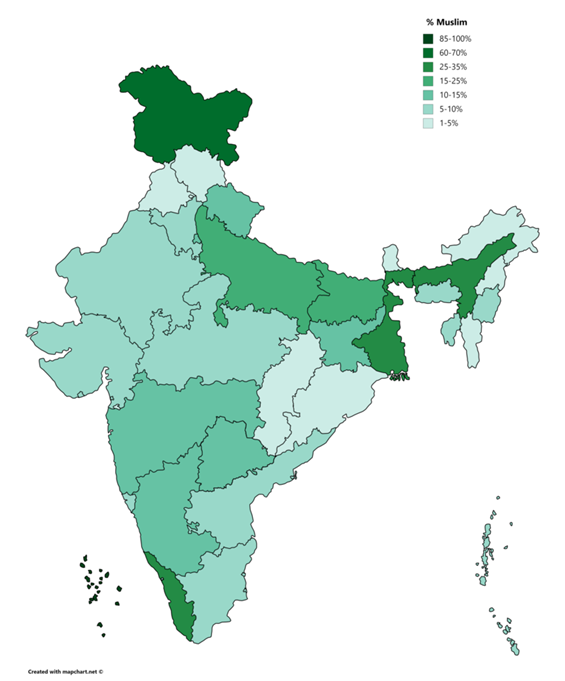
Image Credit: Wikipedia (based on 2011 Census)
States with lowest Muslim Population
| State/UT | Total Population | Muslim Population | Muslim % | Significance |
| Mizoram | 1,097,206 | 14,832 | 1.35% | Negligible |
| Sikkim | 610,577 | 9,867 | 1.62% | Negligible |
| Punjab | 27,743,338 | 535,489 | 1.93% | Negligible |
| Arunachal Pradesh | 1,383,727 | 27,045 | 1.95% | Negligible |
| Chhattisgarh | 25,545,198 | 514,998 | 2.02% | Negligible |
| Orissa | 41,974,218 | 911,670 | 2.17% | Negligible |
| Himachal Pradesh | 6,864,602 | 149,881 | 2.18% | Negligible |
Trend in Growth of Muslim Population in India
India’s Muslim population declined from 42 million in the 1941 census to 35 million in 1951, primarily due to the partition of India, which caused large-scale population movements between India and Pakistan. Later, there has been a consistent increase in the Muslim population in India, rising from 9.8% in 1951 to 14.2% in 2011.
The Muslim population in India has grown at a faster rate than the Hindu population. Between 2019 and 2021, Muslims had the highest fertility rate at 2.36%, contributing significantly to their population growth. During the 1991–2001 period, the Muslim population increased by 29.5%, while the Hindu population grew by 19.9%.
| Year | Muslim Population | % of Total Population |
| 1951 | 35 million (3.5 crore) | 9.80% |
| 1961 | 47 million (4.7 crore) | 10.70% |
| 1971 | 62 million (6.2 crore) | 11.20% |
| 1981 | 83 million (8.3 crore) | 11.70% |
| 1991 | 101 million (10.1 crore) | 12.60% |
| 2001 | 138 million (13.8 crore) | 13.40% |
| 2011 | 172 million (17.2 crore) | 14.20% |
| Key Facts |
| 1. The world’s Muslim population is expected to increase to 2.2 billion by 2030
2. If current trends continue, Muslims will make up 26.4% of the world’s total projected population of 8.3 billion in 2030 – up from 23.4% of the estimated 2010 world population of 6.9 billion. 3. From 1990 to 2010, the global Muslim population increased at an average annual rate of 2.2%, compared with the projected rate of 1.5% for the period from 2010 to 2030. 4. The slowdown in Muslim population growth is most pronounced in the Asia-Pacific region, the Middle East, North Africa and Europe – and less sharp in sub-Saharan Africa. 5. A majority of the world’s Muslims (about 60%) will continue to live in the Asia-Pacific region, while about 20% will live in the Middle East and North Africa. 6. If current trends continue, 79 countries will have a million or more Muslim inhabitants in 2030. 7. Arabic is the fifth-most spoken language in the world – with over 200 million native speakers of Arabic and more than 400 million total speakers of the language. 8. Arabic is one of the six official UN languages, and it is the official or co-official language of 27 countries. Sources: Pew Research Center, Language Connects Foundation, World Population Review |

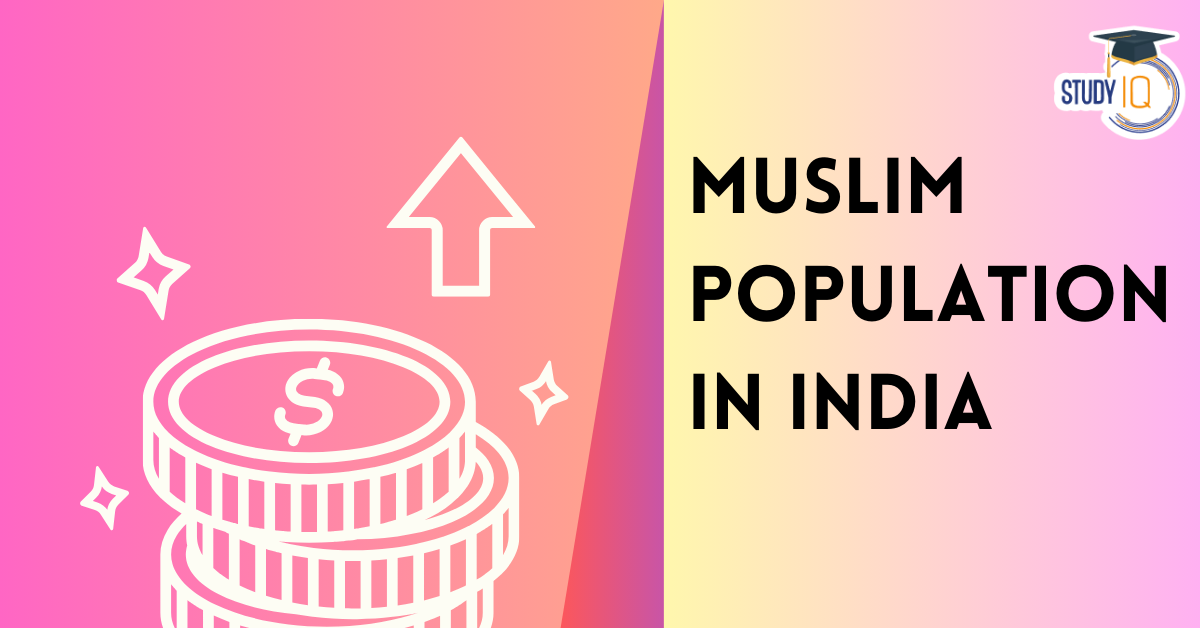
 Gutti Koya Tribals in Post-Conflict Indi...
Gutti Koya Tribals in Post-Conflict Indi...
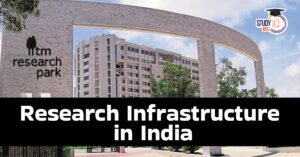 Research Infrastructure in India for its...
Research Infrastructure in India for its...
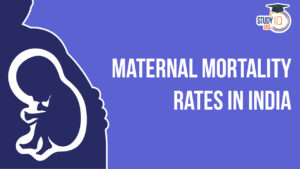 Maternal Mortality Rate in India, State ...
Maternal Mortality Rate in India, State ...





















